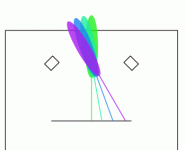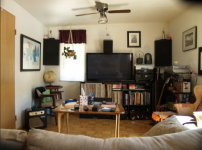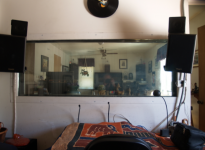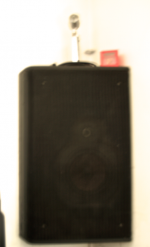No reverberant field - just the direct field. Not even early reflections as yet. The idea is to learn about how different loudspeakers polar responses arrive at the listener in different setup conditions like separation and toe-in.
Early reflections/diffraction <1ms from speaker are primary source of image distortion. This may be thought of as fine polar behavior.
When small changes in toe in/out of one speaker cause image shift in dead room/outdoors, it is the speaker's fault. This leads to shrinking of the sweet spot and loss of image detail.
Reflections >3ms have nothing to do with imaging. These are integrated into loudness. Any spaciousness derived from such reflections are the spaciousness of the listening room, not the recording.
Funny you should mention that, I've been waiting for it to come up on another thread 😉Early reflections/diffraction...primary source of image distortion.
Ok, If a speaker has a rising level toward the opposite side that leads to the first opposite wall reflection mirroring the loudest axis of the speaker, is this worthy of changing the triangle, or is it a reasonable compromise that could be dealt with later?I still don't understand the question. 😕
If time/intensity trading is used out to an un-occupied region, would the effort be wasted on the reverberant field.
Early reflections/diffraction <1ms from speaker are primary source of image distortion. This may be thought of as fine polar behavior.
Reflections >3ms have nothing to do with imaging. These are integrated into loudness. Any spaciousness derived from such reflections are the spaciousness of the listening room, not the recording.
I agree with you in principle, but not necessarily the numbers. One problem is that the numbers are not the same across frequency, but, in general, I think that yours are too small. I think that your last sentence is kind of self evident. "The sky is blue because its blue."
This is why I eventually want to look at the reflection pattern.Ok, If a speaker has a rising level toward the opposite side that leads to the first opposite wall reflection mirroring the loudest axis of the speaker, is this worthy of changing the triangle, or is it a reasonable compromise that could be dealt with later?
If time/intensity trading is used out to an un-occupied region, would the effort be wasted on the reverberant field.
Again, the question here (if it is one) is not clear. And if its just a statement thenh I don't understand.
Just in case anyone wants more subjective reports than two, here's mine:
With any speaker reasonably close to constant directivity behavior, it seems pretty easy to get a phantom center-panned image like my little sketch here, where the lines point to listener location and the ellipses indicate the perceived locations of various centered sounds.
It gets more fussy when it comes to sounds that are panned pretty hard to one side and the listener is closer to that side. Those tend to want to collapse onto the speaker-to-listener axis. The more edge diffraction and early reflections are eliminated, the less this seems to happen, so I'm not sure if those things might be the only cause of the problem, or if there is more to it.
In any case, it's an understatement to say that I find the overall effect of an image that stays relatively stable while moving around very pleasing, even when it's far from perfect.
With any speaker reasonably close to constant directivity behavior, it seems pretty easy to get a phantom center-panned image like my little sketch here, where the lines point to listener location and the ellipses indicate the perceived locations of various centered sounds.
It gets more fussy when it comes to sounds that are panned pretty hard to one side and the listener is closer to that side. Those tend to want to collapse onto the speaker-to-listener axis. The more edge diffraction and early reflections are eliminated, the less this seems to happen, so I'm not sure if those things might be the only cause of the problem, or if there is more to it.
In any case, it's an understatement to say that I find the overall effect of an image that stays relatively stable while moving around very pleasing, even when it's far from perfect.
Attachments
Last edited:
Dumptruck -
Ditto here. I mostly find it very relaxing (as I used to be obsessively bothered by images that required both precise head placement and exact setting of a balance knob).
Ditto here. I mostly find it very relaxing (as I used to be obsessively bothered by images that required both precise head placement and exact setting of a balance knob).
....then I don't understand.
Okey-dokey. Did you catch that game on the box last night? Great, wasn't it. 😀
I sometimes like to ask questions when the opportunity arises, even if I'm ill prepared and really ought to be glueing the side on that tapped horn I'm keen to listen to.
Out of curiosity, with this study would you leave the reflections as pressure when adding them?
Dumptruck -
Ditto here. I mostly find it very relaxing (as I used to be obsessively bothered by images that required both precise head placement and exact setting of a balance knob).
You know I had kind of taken for granted that this image tradeoff worked and created a much more stable image as one shifted seats laterally But there is this one guy for which nothing seems to work.😉
Out of curiosity, with this study would you leave the reflections as pressure when adding them?
I don't think that this would be of much use. What I will probably do is show the impulse response for the reflection cases. The delay and the level of the reflection are, to me, the important aspects and I am interested in how this maps with different speaker directivities and placements. Adding the pressures would yield a real mess, although I will probably look at it.
You know I had kind of taken for granted that this image tradeoff worked and created a much more stable image as one shifted seats laterally But there is this one guy for which nothing seems to work.😉
There's always this one guy that ruins it for everybody. I'm close to tears 🙂
I find it interesting that nobody tried the test I had proposed.
I agree with you in principle, but not necessarily the numbers. One problem is that the numbers are not the same across frequency, but, in general, I think that yours are too small. I think that your last sentence is kind of self evident. "The sky is blue because its blue."
I think your "sky is blue because its blue" response is dismissive hand waving.
All impulsive sounds attracting attention contain higher frequency components. The localization processing time proportional to wavelength. The brain figures out source location from higher frequency components long before lower frequency components can be processed into location. Impulsive sounds devoid of high frequencies have no detailed localization information.
My Pluto Clone are extremely omnidirectional <3kHz. As angle of listening triangle gets wider, by speaker placement or getting head closer to speaker plane, image gets wider and shallower. When I set the speakers up midway in my 25' x 17' living room ( 50% of wall surfaces are brick and glass with no treatment, rest of wall surfaces are wood), placed 3' from long walls with tweeters pointing directly at each other, the image is identical listening from either end of the room.
With speakers placed closer together the image rolls down into floor with head in vertical plane of speakers, and above horizontal plane of speakers. Laying on floor between speakers, image is up in the ceiling.
My room is more of a reflective rectangular prism than an anechoic chamber or outdoors. My expectation is that if all furnishings were removed, the imaging specificity of the speakers would remain, and that the sound would be louder due to room's increased reverberation time.
So, on what basis are my numbers too small?
When i want a wider sweet spot for a center image, i put a derived mono center speaker between the L-R speakers. nails that center image. Just make it slightly lower in magnitude/level than left-right so as to not be obnotiously obvious.
How do you derive the signal for center speaker ?
Just in case anyone wants more subjective reports than two, here's mine:
With any speaker reasonably close to constant directivity behavior, it seems pretty easy to get a phantom center-panned image like my little sketch here, where the lines point to listener location and the ellipses indicate the perceived locations of various centered sounds.
Great diagram- it's exactly what I experience with my CD systems, and my experiences track yours with the rest of it.
I think your "sky is blue because its blue" response is dismissive hand waving.
I am not dismissing it, but it just seems like the comment "Any spaciousness derived from such reflections are the spaciousness of the listening room, not the recording." is obvious since any room reflections are from the listening room and not the recording.
Maybe I missed what you are trying to say, but I read it as "Any audible room reflections are from the room not the recording." Doesn't that go without saying? - unless "room refections" is ambiguos here meaning both the recording venue reflections and the listening room reflections, but that is not how I read it.
Last edited:
There's always this one guy that ruins it for everybody. I'm close to tears 🙂
I find it interesting that nobody tried the test I had proposed.
I don't have the time to do tests like that, I am pretty sure you don't have a family and that makes a big difference. But I always appreciate your opinion as you have a knowledge and objectivity that few here have. But you do always seem to be on the extreme edge of what others believe and perceive.
All impulsive sounds attracting attention contain higher frequency components. The localization processing time proportional to wavelength. The brain figures out source location from higher frequency components long before lower frequency components can be processed into location. Impulsive sounds devoid of high frequencies have no detailed localization information.
So, on what basis are my numbers too small?
I agree with you completely although there are many here who would not. I think summing localization, when taken as a single number average across the audio bandwidth, would be higher than 1 ms. and that imaging effects would likely still be significant above 3 ms. But, as I said, I agree with you in principle and arguing about 1.5 ms versus 1 ms does not seem fruitful.
It's hard to pull any single number for summing localization from Blauert, but in section 3.1 he quotes an "average" time interval for a displaced judgement in a test to be 2 ms. I'm not saying this IS the number nor does he say that, but it is significantly longer (double) what you were stating.
How are you definining "image".
It is known that some people can't perceive a correct phantom image. So if someone tells you this technique doesn't work, take it with a grain of salt. It works very well.
A phantom center jumps to the nearest speaker when I move to the left and the right just like it would with the standard 60° triangle.
The phantom will still move, and still favor nearest speaker if you move far enough to left or right. What the toe-in does is minimize this effect as much as possible, and thereby increase the sweet spot as much as possible and lock in imaging for a given pair
... The imaging can be holographic!
I In fact my usual seat is almost directly in front of the right speaker with hardly any image shift when I move to center (this using 90 degree conical waveguides).
With any speaker reasonably close to constant directivity behavior, it seems pretty easy to get a phantom center-panned image like my little sketch here
Great diagram- it's exactly what I experience with my CD systems, and my experiences track yours with the rest of it.
There is a lot of talk about phantom center and phantom image here. I'd like to know, what happens to more than one image between your speakers, if you move to one side - let's say the left.
This would be the scene if you sit in the middle between the speakers:
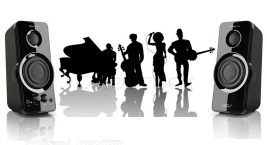
Now you move to the left. Do the musicians stay in their place? Or do they move as an entity towards the left speaker:
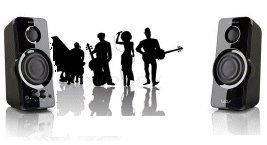
Are they compressed:
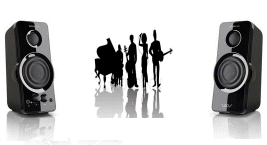
Are they blurred in any way:
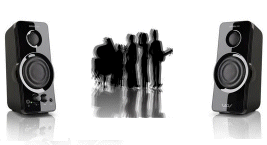
Are they compressed and moved towards the left speaker:
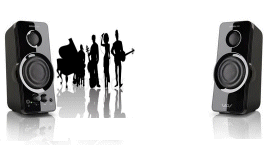
Or are they even progressively compressed:
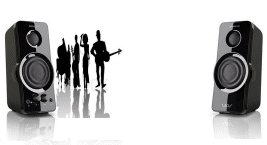
Or does it happen in a completely different way?
Rudolf
Rudolf,There is a lot of talk about phantom center and phantom image here. I'd like to know, what happens to more than one image between your speakers, if you move to one side - let's say the left.
This would be the scene if you sit in the middle between the speakers:
Now you move to the left. Do the musicians stay in their place? Or do they move as an entity towards the left speaker:
Are they compressed:
Are they blurred in any way:
Are they compressed and moved towards the left speaker:
Or are they even progressively compressed:
Or does it happen in a completely different way?
Rudolf
The answer to any and all of your questions depend on the dispersion pattern of your speakers, their location in the room, toe in angle, room size, shape and reflectivity.
Art
Marcus,Did the following test: Played correlated pink noise with the same level in L and R. There's a strong center phantom image when listening at the sweetspot.
I moved 50cm to the right. The phantom image snaps to the right speaker.
Now I did raise the level of the left speaker in order to move the phantom image back to the center.
This did not work. At one point the left speaker becomes localizable as a distinct additional source. Localization is somewhat diffuse with noise coming from in between both speakers.
At about 10dB difference noise is fully localized in the left speaker.
Anybody else could try this and report his findings?
I tried listening to mono pink noise at a level of about 78 dBC and shuffling my feet with my eyes closed across my room just in front of my couch listening location which puts one's head in the center of the room.
The speakers are corner wall mounted, toed in to point at the opposing room corner, room dimensions are 11 foot wide x 20 long x 8 & 7.5 high, 3.38 meters x 6.15 x 2.46 x 2.3.
No subjective off center "snapping" of the phantom image with this set up.
That said, what "snaps" to your ears might be a brush to mine..
When the speaker levels are balanced, the general "phantom location" of the noise appears to be directly in front of the listening location from left to right across the room.
The sense of location is not very identifiable other than being centered in front over the middle 1/3 of the left to right listening location.
When going left or right from the middle 1/3 the image appears to be more a vector sum, L/R locatable points "averaging" as one in between when outside the center 1/3 listening location.
This effect changes to a direct in front location when shouldered up to the side wall.
Reducing level of the right speaker 10 dB the only "balance point" was about 2 feet (.6 meter) in front of that speaker, any other position the left speaker was the obvious location of the noise.
Reducing level of the right speaker 5 dB the "balance point" moved to in front of that speaker at the original listening distance, about 8.5 feet (2.6 meters) back from the speakers, all the way to the wall.
Subjectively, listening to a mono spoken voice, same general perceptions.
Listening to stereo classical music, the general locations of recorded placements seem to stay relatively placed while moving across the center of the room in front of or sitting on the couch.
Towards the back of the room the sound is too diffuse to specifically locate recorded sources that are not hard panned left or right.
Art
Attachments
Last edited:
Thanks Art -now Markus can't complain anymore that we are ignoring him🙂
As with all things, I am motivated to the theory and the mathematics and look to that as a handle on what will happen. I am not much for "listening tests" because they generally haven't worked out too well for me I guess.
Rudolf - my impression is that there is some compression of the stage width as one move laterally and that the center of this image moves slightly with the location. As above, I don't know how to represent this mathematically so I used the best that I could find which was the Blauert curves.
As with all things, I am motivated to the theory and the mathematics and look to that as a handle on what will happen. I am not much for "listening tests" because they generally haven't worked out too well for me I guess.
Rudolf - my impression is that there is some compression of the stage width as one move laterally and that the center of this image moves slightly with the location. As above, I don't know how to represent this mathematically so I used the best that I could find which was the Blauert curves.
- Status
- Not open for further replies.
- Home
- Loudspeakers
- Multi-Way
- New study on loudspeaker placement
